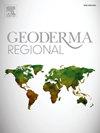宣城红壤风化过程铜同位素特征及其对土壤网状结构的意义
IF 3.3
2区 农林科学
Q2 SOIL SCIENCE
引用次数: 0
摘要
铜同位素(δ65Cu)对研究风化作用、成土过程和古环境演化具有重要意义。然而,Cu在复杂土壤形成系统中的行为及其同位素分馏机制尚不清楚。华南宣城剖面具有鲜明的网状结构,由白色脉体和红色基质组成。它是研究具有复杂氧化还原和发育历史的成土系统中Cu同位素变化的一个很好的野外实验室。结果表明,Cu主要存在于黏土矿物中,其同位素组成变化范围为- 0.29 ± 0.02 ‰~ - 0.15 ± 0.02 ‰(相对于NIST 976)。在现代土层(MSL)和均质红土层(HREL)中,大块Cu同位素(−0.22 ~−0.15 ‰)与残余部分(δ65Cures = ~ 0.29 ~−0.21 ‰)相似,表明黏土矿物中的Cu在氧化风化过程中相对稳定。中下层网状红土层铜同位素组成受网状过程中氧化还原变化的影响。在中间RREL(1.7 ~ 2.4 m), δ65Cu的变化与弱网状过程中氧化铁的分解或转化有关。粘土组合、块状土壤和残余组分的Cu同位素表明,RREL中Cu同位素的变化与网状过程的存在呈正相关,而与网状过程的强度无关。白色脉体中Cu的同位素含量高于红色基质,这与季节性干湿气候条件下含轻Cu的氧化铁在红色基质中的溶解有关。这些结果促进了我们对成土环境化学风化过程中cu同位素分馏机制的认识。本文章由计算机程序翻译,如有差异,请以英文原文为准。
Copper isotope signatures during red earth weathering and their significance for soil reticulation (Xuancheng, South China)
Copper isotopes (δ65Cu) can provide critical insights in the study of weathering, pedogenic processes, and paleoenvironmental evolution. However, the behavior of Cu and its isotopic fractionation mechanisms in complex soil-forming systems are not well known. The Xuancheng profile in South China is characterized by a distinctive reticulate structure, consisting of white veins and red matrix. It is an excellent field laboratory for the study of Cu isotope variation in pedogenic systems with complex redox and developmental histories. Our results show that Cu is present mainly in clay minerals, and its isotopic composition exhibits limited variability, ranging from −0.29 ± 0.02 ‰ to −0.15 ± 0.02 ‰ (relative to NIST 976). In the modern soil layer (MSL) and homogenous red earth layer (HREL), bulk Cu isotopes (−0.22 to −0.15 ‰) are similar to those of the residual fraction (δ65Cures = −0.29 to −0.21 ‰), suggesting that Cu in clay minerals is relatively stable during oxic weathering. Cu isotopic compositions in the middle and lower reticulated red earth layer (RREL) were affected by redox variations during the reticulation process. In the middle RREL (1.7–2.4 m), δ65Cu variation was related to decomposition or transformation of iron oxides during weak reticulation. The clay assemblages, Cu isotopes of bulk soil and residual fractions indicate that Cu isotopic variation in the RREL was positively correlated with the presence of reticulation but not to the intensity of the reticulation process. Furthermore, the white veins contain isotopically heavier Cu than the red matrix of the LRREL, which was related to dissolution of iron oxides containing isotopically light Cu in the red matrix under seasonally wet-dry climate conditions. These results advance our understanding of the mechanisms of Cu-isotopic fractionation during chemical weathering in pedogenic environments.
求助全文
通过发布文献求助,成功后即可免费获取论文全文。
去求助
来源期刊

Geoderma Regional
Agricultural and Biological Sciences-Soil Science
CiteScore
6.10
自引率
7.30%
发文量
122
审稿时长
76 days
期刊介绍:
Global issues require studies and solutions on national and regional levels. Geoderma Regional focuses on studies that increase understanding and advance our scientific knowledge of soils in all regions of the world. The journal embraces every aspect of soil science and welcomes reviews of regional progress.
 求助内容:
求助内容: 应助结果提醒方式:
应助结果提醒方式:


